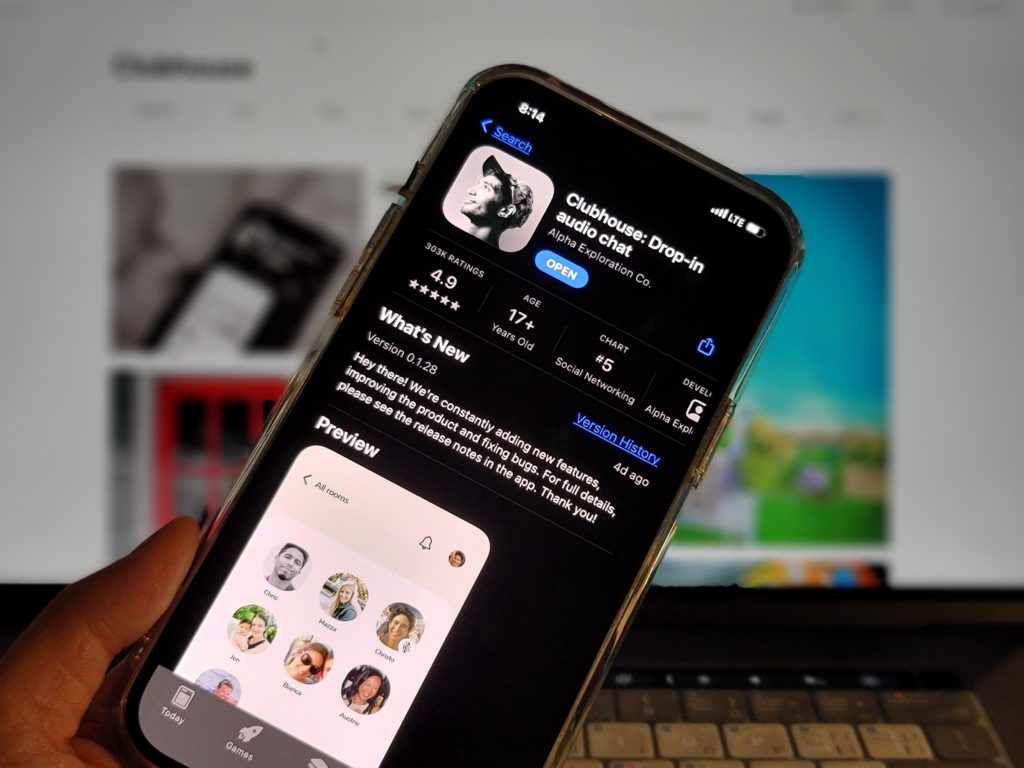Clubhouse: must-have social media app or all hype?

If you follow tech news at all, you’ve probably come across this app several times, without necessarily understanding what it’s all about. Clubhouse is the invitation-only platform that everyone’s been talking about for over a year. But what is it exactly? Is all the fuss really justified or will it end up in the hype graveyard? Let’s take a deeper look.
Before discussing the durability of this trendy new app, let’s recap what it consists of. Officially launched in the midst of the COVID-19 pandemic (March 2020) and initially exclusively on iOS, Clubhouse offers a social network focused on audio. But more than a simple Skype-style voice chat, the app brings a concept to social networks that comes straight from grandpa’s radio: the good old drop-in. This practice consisted of calling your favourite station from a phone to give your opinion on a random topic, or simply to chat with a presenter or a famous guest.
The connection with radio becomes even more obvious when we look at how this project was born. Initially called Talkshow, the app was aimed at podcast producers, offering them a new way of connecting with their audience. These ambitions quickly expanded, causing the start-up’s founders, Paul Davison and Rohan Seth, to rename their project.
Today, Clubhouse allows anyone with a precious invitation (distributed sparingly) to create their own chat room, which can accommodate up to 5,000 people. All of this is enhanced by a moderation system that allows hosts to easily grant the floor to participants who wish to speak. A new way to gather communities, with obvious potential interest for companies, brands and public figures.

A golden idea… that doesn’t make any money
The only downside to this great idea is that Clubhouse is a free app and doesn’t generate any revenue yet. Monetisation projects are being studied (such as a subscription system, the possibility for the public to make donations, or selling virtual tickets to access certain rooms), but the company only lives on fundraising at the moment. And even if things are going well on that front (several million raised for a valuation that now stands at $4 billion), the survival of the app is uncertain, especially after the failed Twitter acquisition last April. A concern that seems to be confirmed by the figures: from February to April 2021, Clubhouse went from 9.6 million downloads to… barely 900,000.
If the concept was seductive at the beginning, the facts are now indisputable: most of the ‘celebrities’ who were once the attraction of the platform have now deserted it. The aura surrounding the very exclusive invitation system for accessing the platform has also faded, even for the geeks who were still competing for these precious passes not so long ago. The platform has also had to deal with a number of unexpected problems that have certainly not helped it establish itself.
Between image problems (particularly linked to impostors and the existence of communities that are, to say the least, peculiar), the inevitable bugs (and their often crucial impact on privacy), and even controversies (such as the recent one involving the unfortunate Lakeith Standfield, a passive moderator of anti-Semitic comments), the path has been full of pitfalls. In an attempt to repair the damage, the once iOS-only app has now opened up to the Android ecosystem. Will this be enough? Probably not, and it’s likely that Clubhouse will soon join other wrecked digital experiences, such as Periscope or Vine, in oblivion.
So why should we be interested in it?
This apparent failure shouldn’t necessarily be an end in itself. Because it’s the app’s operating principle that deserves our attention. As is always the case with social networks, competitors have been quick to steal some of its ideas. Just as Snapchat’s stories was replicated by Instagram, everyone is now trying to jump on the audio bandwagon.
Whether it’s Facebook (with its Live Audio Rooms), Twitter (with its Spaces) or Discord (with its Stage Channels), everyone’s currently working on their own version of the concept. There is a bunch of users ready to invest time in this type of real-time participatory audio content, even if the experience is not very meaningful or relatively mediocre. This craze naturally aroused the interest of the major social networking platforms, with the same objective that has driven them since their creation: to keep their users as captive as possible. So even if Clubhouse disappears from the radar, the concept is bound to spread.

A new channel
For brands, influencers, or even artists looking to strengthen ties with their communities, this new way of communicating undoubtedly offers new opportunities that deserve to be explored. Even if, in the end, this new foresight doesn’t happen on Clubhouse but on Facebook, Twitter or Discord – platforms with which most are already familiar.
It’s a communication channel that opens the door to new user experiences: recipe competitions for KitchenAid, cocktails and debates for Dove and travel stories for Brussels Airlines. The possibilities for interaction are almost unlimited. Clubhouse may already be a thing of the past, but the idea behind it should live on and potentially enrich our digital presence.
Our recent blog posts
See all blogs-
How is AI’s synthetic data enhancing User Experience Research? Technology

-
Web3.AI Rising : How new technology can add value to your business

-
How generative AI helped us create an e-commerce app – with personalised content – in just 2 weeks Technology

-
Can you build a foodie app in 3 days using Generative AI? (Spoiler alert: yes!)

